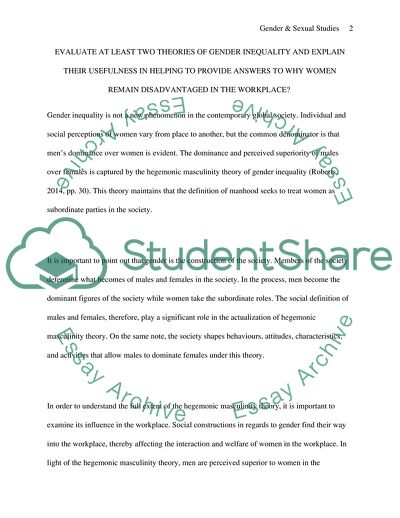Cite this document
(Two Theories of Gender Inequality Assignment Example | Topics and Well Written Essays - 2750 words, n.d.)
Two Theories of Gender Inequality Assignment Example | Topics and Well Written Essays - 2750 words. https://studentshare.org/gender-sexual-studies/1847981-evaluate-at-least-two-theories-of-gender-inequality-eg-hegemonic-masculinity-patriarchy-intersectionality-and-explain-their-usefulness-in-helping-to-provide-answers-to-why-women-remain-disadvantaged-in-the-workplace
Two Theories of Gender Inequality Assignment Example | Topics and Well Written Essays - 2750 words. https://studentshare.org/gender-sexual-studies/1847981-evaluate-at-least-two-theories-of-gender-inequality-eg-hegemonic-masculinity-patriarchy-intersectionality-and-explain-their-usefulness-in-helping-to-provide-answers-to-why-women-remain-disadvantaged-in-the-workplace
(Two Theories of Gender Inequality Assignment Example | Topics and Well Written Essays - 2750 Words)
Two Theories of Gender Inequality Assignment Example | Topics and Well Written Essays - 2750 Words. https://studentshare.org/gender-sexual-studies/1847981-evaluate-at-least-two-theories-of-gender-inequality-eg-hegemonic-masculinity-patriarchy-intersectionality-and-explain-their-usefulness-in-helping-to-provide-answers-to-why-women-remain-disadvantaged-in-the-workplace.
Two Theories of Gender Inequality Assignment Example | Topics and Well Written Essays - 2750 Words. https://studentshare.org/gender-sexual-studies/1847981-evaluate-at-least-two-theories-of-gender-inequality-eg-hegemonic-masculinity-patriarchy-intersectionality-and-explain-their-usefulness-in-helping-to-provide-answers-to-why-women-remain-disadvantaged-in-the-workplace.
“Two Theories of Gender Inequality Assignment Example | Topics and Well Written Essays - 2750 Words”. https://studentshare.org/gender-sexual-studies/1847981-evaluate-at-least-two-theories-of-gender-inequality-eg-hegemonic-masculinity-patriarchy-intersectionality-and-explain-their-usefulness-in-helping-to-provide-answers-to-why-women-remain-disadvantaged-in-the-workplace.


